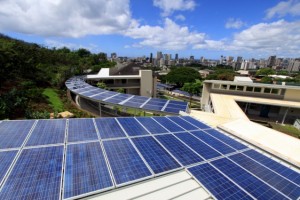
From ThinkProgress: Hawaii Will Soon Get All Of Its Electricity From Renewable Sources
The state legislature sent a bill to the governor’s desk this week that moves the renewable portfolio standard (RPS) up to 100 percent by 2045 — which means that all electricity provided by the electric companies will have to come from renewable sources like solar and wind. Nationwide, electricity generation makes up about a third of all carbon emissions.
“We’ll now be the most populated set of islands in the world with an independent grid to establish a 100 percent renewable electricity goal,” State Senator Mike Gabbard (D) told ThinkProgress in an email. “Through this process of transformation we can be the model that other states and even nations follow. And we’ll achieve the biggest energy turnaround in the country, going from 90 percent dependence on fossil fuels to 100 percent clean energy.”
One out of every eight homes in Hawaii has solar. Commercially, 10 percent of the electricity comes from solar and about 25% from geothermal. But most of Hawaii’s electricity is from expensive oil burning power plants which makes the transition to solar an economic win and an environmental win.
Island Pacific Energy is one of the companies at the forefront:
At Island Pacific Energy we believe that a photovoltaic system is one of the best investments you can make. […]
We understand that a renewable energy facility is about more than lower energy costs and stable electric rates. It’s about the opportunity to provide knowledge and information about conservation, renewability, sustainability and respecting the environment.
Another company planning on getting into the market talks about the new Tesla battery:
SolarCity co-founder Lydon Rive said his company plans to offer solar plus storage in Hawaii next year, allowing homeowners to go completely off the grid, as E&E News reported this week. The new Tesla battery can serve as a “hedge against bad policy outcomes,” Rive said.
From Tesla, the Powerwall:
Powerwall is a home battery that charges using electricity generated from solar panels, or when utility rates are low, and powers your home in the evening. It also fortifies your home against power outages by providing a backup electricity supply. Automated, compact and simple to install, Powerwall offers independence from the utility grid and the security of an emergency backup.
Solar Powered Day and Night
The average home uses more electricity in the morning and evening than during the day when solar energy is plentiful. Without a home battery, excess solar energy is often sold to the power company and purchased back in the evening. This mismatch adds demand on power plants and increases carbon emissions. Powerwall bridges this gap between renewable energy supply and demand by making your home’s solar energy available to you when you need it.
Powerwall announcement, April 30, 2015
Elon Musk: “Let’s not win the Darwin award”.
Good advice.

The islands’ electric companies are the biggest bottleneck:
From the Think Progress article:
I hope the PSC holds their feet to the fire.
One state moving forward, another moving backward: In Kansas, Renewable Energy Could Soon Be A Goal, Not A Requirement